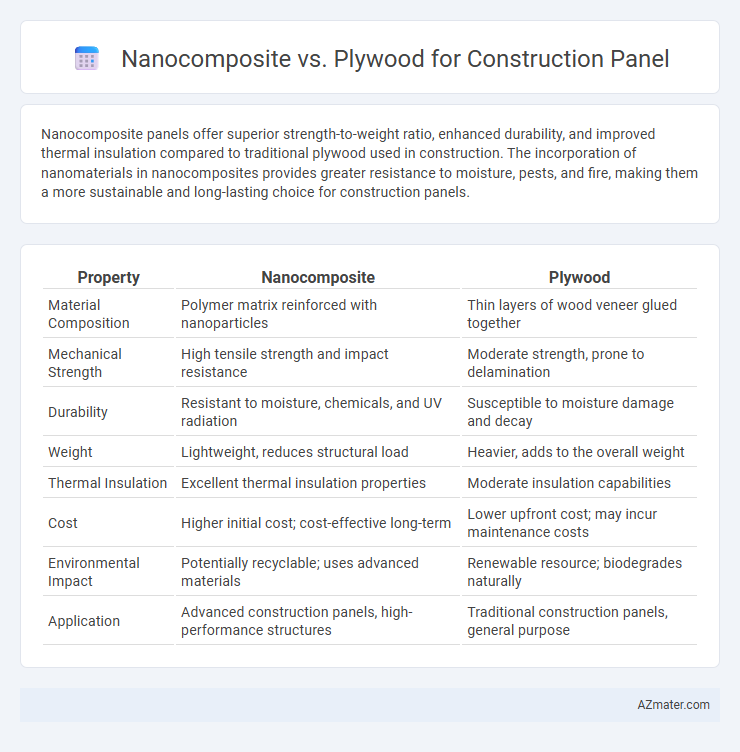Nanocomposite panels offer superior strength-to-weight ratio, enhanced durability, and improved thermal insulation compared to traditional plywood used in construction. The incorporation of nanomaterials in nanocomposites provides greater resistance to moisture, pests, and fire, making them a more sustainable and long-lasting choice for construction panels.
Table of Comparison
| Property | Nanocomposite | Plywood |
|---|---|---|
| Material Composition | Polymer matrix reinforced with nanoparticles | Thin layers of wood veneer glued together |
| Mechanical Strength | High tensile strength and impact resistance | Moderate strength, prone to delamination |
| Durability | Resistant to moisture, chemicals, and UV radiation | Susceptible to moisture damage and decay |
| Weight | Lightweight, reduces structural load | Heavier, adds to the overall weight |
| Thermal Insulation | Excellent thermal insulation properties | Moderate insulation capabilities |
| Cost | Higher initial cost; cost-effective long-term | Lower upfront cost; may incur maintenance costs |
| Environmental Impact | Potentially recyclable; uses advanced materials | Renewable resource; biodegrades naturally |
| Application | Advanced construction panels, high-performance structures | Traditional construction panels, general purpose |
What Are Nanocomposites?
Nanocomposites are advanced materials composed of a polymer matrix embedded with nanoscale fillers such as nanoparticles, nanofibers, or nanoclays, enhancing mechanical strength, thermal stability, and durability compared to traditional materials. In construction panels, nanocomposites offer superior resistance to moisture, fire, and environmental degradation, making them an innovative alternative to conventional plywood. These properties result from the high surface area and unique interactions of nanofillers within the matrix, providing lightweight panels with improved load-bearing capacity and longevity.
Defining Plywood in Construction
Plywood in construction consists of multiple layers of wood veneers glued together with grain patterns oriented perpendicularly to enhance strength and stability. It offers flexibility, cost-effectiveness, and ease of use, making it a common choice for wall sheathing, flooring, and roofing panels. Compared to nanocomposites, plywood is more prone to moisture damage and limited in mechanical performance but remains widely used due to its availability and traditional manufacturing processes.
Comparative Strength and Durability
Nanocomposite panels exhibit superior strength-to-weight ratios compared to plywood, with enhanced resistance to impact and structural deformation due to nanoparticle reinforcement. The durability of nanocomposites surpasses plywood by offering increased resistance to moisture, fungal decay, and ultraviolet radiation, resulting in longer lifespan in harsh environmental conditions. Plywood remains vulnerable to delamination and warping under prolonged exposure, whereas nanocomposites maintain mechanical integrity and dimensional stability over extended periods.
Weight and Flexibility Differences
Nanocomposite panels offer significantly lower weight compared to traditional plywood, enhancing ease of handling and reducing structural load in construction applications. The flexibility of nanocomposites surpasses plywood due to their engineered polymer matrices combined with nanomaterial reinforcement, allowing better deformation tolerance without cracking. Plywood, composed of layered wood veneers, provides moderate flexibility but is heavier and less adaptable to complex shapes than advanced nanocomposite alternatives.
Moisture Resistance and Weather Performance
Nanocomposite panels exhibit superior moisture resistance compared to plywood due to their enhanced polymer matrix and nanofiller integration, which significantly reduce water absorption and swelling. The advanced nanomaterials in nanocomposites improve weather performance by providing enhanced UV stability, corrosion resistance, and durability against temperature fluctuations. Plywood, with its natural wood layers, tends to degrade faster under prolonged exposure to moisture and harsh weather, making nanocomposite panels a more reliable choice for outdoor and high-humidity construction environments.
Fire Resistance: Nanocomposites vs Plywood
Nanocomposite panels exhibit superior fire resistance compared to traditional plywood, due to the incorporation of flame-retardant nanoparticles that enhance thermal stability and reduce flammability. Plywood, being organic and wood-based, is more susceptible to ignition and rapid combustion under high temperatures. The improved fire resistance of nanocomposites makes them a safer choice for construction applications requiring compliance with stringent fire safety regulations.
Environmental Impact and Sustainability
Nanocomposite panels offer superior environmental benefits over plywood by utilizing engineered nanoparticles to enhance durability and reduce the need for frequent replacement, minimizing resource consumption and waste production. Plywood production often involves significant deforestation and the use of formaldehyde-based adhesives, which contribute to habitat loss and indoor air pollution, whereas nanocomposites can be manufactured with eco-friendly materials and lower volatile organic compound emissions. Sustainable construction increasingly favors nanocomposites due to their longer lifespan, recyclability potential, and reduced environmental footprint throughout the lifecycle compared to conventional plywood.
Cost Considerations and Availability
Nanocomposite panels often have higher upfront costs due to advanced manufacturing processes and specialized materials like nanoparticles, limiting their widespread availability compared to plywood. Plywood remains more cost-effective and widely accessible, benefiting from established production and a global supply chain, making it a preferred choice for budget-conscious construction projects. Evaluating long-term durability and performance can justify the initial investment in nanocomposites despite their higher price and lower availability.
Applications in Modern Construction
Nanocomposites offer superior mechanical strength, thermal insulation, and moisture resistance compared to traditional plywood, making them ideal for high-performance construction panels. Modern construction leverages nanocomposite panels in energy-efficient building envelopes, soundproofing, and load-bearing structures where durability and lightweight properties are critical. Plywood remains popular for cost-effective interior applications and temporary frameworks, but nanocomposite panels dominate advanced architectural designs requiring enhanced longevity and environmental sustainability.
Future Trends: Nanocomposites or Plywood?
Nanocomposites offer superior strength-to-weight ratios, enhanced durability, and improved resistance to moisture and pests compared to traditional plywood, positioning them as a promising material for future construction panels. Innovations in nanotechnology enable the incorporation of nanomaterials like carbon nanotubes and nanoclays, which significantly boost mechanical and thermal properties while reducing environmental impact. As sustainability and performance demands rise, nanocomposites are anticipated to surpass plywood in construction applications, driving industry shifts towards advanced, high-performance panel solutions.

Infographic: Nanocomposite vs Plywood for Construction panel
 azmater.com
azmater.com